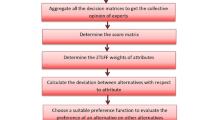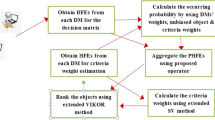Abstract
Multi-criteria group decision-making (MCGDM) problems are very common in the real world. The complexity of the problem necessitates a solution method that is more in line with the decision-making habits of decision-makers (DMs). This paper introduces a novel type of integrated linguistic information, namely, the Probabilistic Hesitant Fuzzy Linguistic Sets (PHFLSs), which combines the concepts of Hesitant Fuzzy Linguistic Sets and Probabilistic Linguistic Term Sets for solving MCGDM problems. By integrating PHFLSs into the Preference Ranking Organization Method for Enrichment Evaluations II (PROMETHEE II), a group decision-making framework is constructed to effectively generate the best decision given various evaluations from multiple DMs. More specifically, the DMs’ assessments are first developed and normalized based on PHFLSs definitions. Then the Hausdorff distance is employed to compute the distances between different PHFLSs, from which the weights of criteria are derived and then fed into PROMETHEE II for the best group decision. To demonstrate the practicality and capability of the proposed decision framework, a case study on seeking the best open-source software project is presented and discussed.

Similar content being viewed by others
References
Herrera, F., Herrera-Viedma, E., Verdegay, J.L.: A model of consensus in group decision making under linguistic assessments. Fuzzy Sets Syst. 78(1), 73–87 (1996)
Zadeh, L.A.: Fuzzy sets. Inf. Control 8(3), 338–353 (1965)
Torra, V., Narukawa, Y.: On hesitant fuzzy sets and decision. In: The 18th IEEE International Conference on Fuzzy Systems, Jeju Island, Korea, pp. 1378–1382 (2009)
Torra, V.: Hesitant fuzzy sets. Int. J. Intell. Syst. 25(6), 529–539 (2010)
Rodríguez, R.M., Marínez, L., Herrera, F.: Hesitant fuzzy linguistic term sets for decision making. IEEE Trans. Fuzzy Syst. 20, 109–119 (2012)
Pedrycz, W.: Granular Computing: Analysis and Design of Intelligent Systems. CRC Press, Boca Raton (2013)
Wei, C.P., Zhao, N., Tang, X.J.: Operators and comparisons of hesitant fuzzy linguistic term sets. IEEE Trans. Fuzzy Syst. 22, 575–585 (2014)
Liu, X.Y., Ju, Y.B., Qu, Q.X.: Hesitant fuzzy 2-dimension linguistic term set and its application to multiple attribute group decision making. Int. J. Fuzzy Syst. 20(7), 2301–2321 (2017)
Li, W.M., Deng, X.: Multi-parameter portfolio selection model with some novel score-deviation under dual hesitant fuzzy environment. Int. J. Fuzzy Syst. 22(4), 1123–1141 (2020)
Lin, R., Zhao, X.F., Wang, H.J., Wei, G.: Hesitant fuzzy linguistic aggregation operators and their application to multiple attribute decision making. J. Intell. Fuzzy Syst. 36(11), 2155–2165 (2014)
Wang, J.H., Hao, J.: A new version of 2-tuple fuzzy linguistic representation model for computing with words. IEEE Trans. Fuzzy Syst. 14(3), 435–445 (2006)
Wu, Z.B., Xu, J.: Possibility distribution-based approach for MAGDM with hesitant fuzzy linguistic information. IEEE Trans. Cybern. 46(3), 694–705 (2016)
Pang, Q., Wang, H., Xu, Z.S.: Probabilistic linguistic term sets in multi-attribute group decision making. Inf. Sci. 369, 128–143 (2016)
Wu, X.L., Liao, H.C.: An approach to quality function deployment based on probabilistic linguistic term sets and ORESTE method for multi-expert multi-criteria decision making. Inf. Fusion 43, 13–26 (2018)
Yu, X.B., Chen, H., Ji, Z.: Combination of probabilistic linguistic term sets and PROMETHEE to evaluate meteorological disaster risk: case study of southeastern China. Sustainability 11(5), 1405 (2019)
Chen, Z.S., Chin, K.S., Li, Y.L., Yang, Y.: Proportional hesitant fuzzy linguistic term set for multiple criteria group decision making. Inf. Sci. 357, 61–87 (2016)
Chen, Z.S., Li, M., Kong, W.T., Chin, K.S.: Evaluation and selection of HazMat transportation alternatives: a PHFLTS and TOPSIS-integrated multi-perspective approach. Int. J. Environ. Res. Public Health 16, 4116 (2019)
Joshi, D., Beg, I., Kumar, S.: Hesitant probabilistic fuzzy linguistic sets with applications in multi-criteria group decision making problems. Mathematics 6(4), 47 (2018)
Xu, Y., Li, Y., Zheng, L.J., Cui, L., Li, S., Li, W., Cai, Y.P.: Site selection of wind farms using GIS and multi-criteria decision making method in Wafangdian, China. Energy 207, 118222 (2020)
Kai, Z., Zhan, J.M., Wu, W.Z.: Novel fuzzy rough set models and corresponding applications to multi-criteria decision-making. Fuzzy Sets Syst. 383, 92–126 (2020)
Ho, W., Xu, X.W., Dey, P.K.: Multi-criteria decision making approaches for supplier evaluation and selection: a literature review. Eur. J. Oper. Res. 202(1), 16–24 (2010)
Velasquez, M., Hester, P.T.: An analysis of multi-criteria decision making methods. Int. J. Oper. Res. 10(2), 56–66 (2013)
Brans, J.P., Vincke, P.: A preference ranking organisation method. Manag. Sci. 31(6), 647–656 (1985)
Liu, P.D., Li, Y.: The PROMTHEE II method based on probabilistic linguistic information and their application to decision making. Informatica 29(2), 303–320 (2018)
Qiao, D., Shen, K.W., Wang, J.Q., Wang, T.L.: Multi-criteria PROMETHEE method based on possibility degree with Z-numbers under uncertain linguistic environment. J. Ambient Intell. Hum. Comput. 11, 2187–2201 (2019)
Feng, F., Xu, Z.S., Fujita, H., Liang, M.Q.: Enhancing PROMETHEE method with intuitionistic fuzzy soft sets. Int. J. Intell. Syst. 35(7), 1071–1104 (2020)
Vavatsikos, A.P., Demesouka, O.E., Anagnostopoulos, K.P.: GIS-based suitability analysis using fuzzy PROMETHEE. J. Environ. Plan. Manag. 63(4), 604–628 (2020)
Hwang, C.L., Yoon, K.: Multiple attribute decision making. Lect. Notes Econ. Math. Syst. 404(4), 287–288 (1981)
Lei, F., Wei, G.W., Gao, H., Wu, J., Wei, C.: Topsis method for developing supplier selection with probabilistic linguistic information. Int. J. Fuzzy Syst. 22, 749–759 (2020)
Opricovic, S., Tzeng, G.H.: Compromise solution by MCDM methods: a comparative analysis of VIKOR and TOPSIS. Eur. J. Oper. Res. 2(156), 445–455 (2004)
Gao, H., Ran, L.G., Wei, G.W., Wei, C., Wu, J.: VIKOR method for MAGDM based on q-rung interval-valued orthopair fuzzy information and its application to supplier selection of medical consumption products. Int. J. Environ. Res. Public Health 17(2), 525 (2020)
Yu, S.M., Wang, J., Wang, J.Q.: An extended TODIM approach with intuitionistic linguistic numbers. Int. Trans. Oper. Res. 25(3), 781–805 (2018)
Wu, Q., Liu, X.W., Qin, J.D., Wang, W.Z., Zhou, L.G.: A linguistic distribution behavioral multi-criteria group decision making model integrating extended generalized TODIM and quantum decision theory. Appl. Soft Comput. 98, 106757106757 (2020)
Lin, M.W., Chen, Z.Y., Liao, H.C., Xu, Z.S.: ELECTRE II method to deal with probabilistic linguistic term sets and its application to edge computing. Nonlinear Dyn. 96(3), 2125–2143 (2019)
Akram, M., Ilyas, F., Garg, H.: Multi-criteria group decision making based on ELECTRE I method in Pythagorean fuzzy information. Soft Comput. 24(5), 3425–3453 (2020)
Ju, Y.B., Wang, A.H., You, T.H.: Emergency alternative evaluation and selection based on ANP, DEMATEL, and TL-TOPSIS. Nat. Hazards 75, 347–379 (2015)
Yazdi, M., Nedjati, A., Zareic, E., Abbassi, R.: A novel extension of DEMATEL approach for probabilistic safety analysis in process systems. Saf. Sci. 121, 119–136 (2020)
Saaty, T.L.: Decision-making with the AHP: why is the principal eigenvector necessary. Eur. J. Oper. Res. 145(1), 85–91 (2003)
Ruiz, H.S., Sunarso, A., Ibrahim-bathis, K., Murti, S. A., Budiarto, I.: GIS-AHP multi-decision-criteria-analysis for the optimal location of solar energy plants at Indonesia. arXiv preprint (2020). arXiv: 2007.15351
Rezaei, J.: Best-worst multi-criteria decision-making method. Omega 53, 49–57 (2015)
Yang, C.X., Wang, Q.Z., Peng, W.D., Zhu, J.: A multi-criteria group decision-making approach based on improved BWM and multimoora with normal wiggly hesitant fuzzy information. Int. J. Comput. Intell. Syst. 13(1), 366–381 (2020)
Wu, Z.J., Zhang, S.T., Liu, X.D., Wu, J.: Best-worst multi-attribute decision making method based on new possibility degree with probabilistic linguistic information. IEEE Access 7, 133900–133913 (2019)
Liao, H.C., Qin, R., Gao, C.Y., Wu, X.L., Hafezalkotob, A., Herrera, F.: Score-HeDLiSF: a score function of hesitant fuzzy linguistic term set based on hesitant degrees and linguistic scale functions: An application to unbalanced hesitant fuzzy linguistic MULTIMOORA. Inf. Fusion 48, 39–54 (2019)
Brauers, W.K.M., Zavadskas, E.K.: Robustness of MULTIMOORA: a method for multi-objective optimization. Informatica 1(1), 1–25 (2011)
Liao, H.C., Jiang, L.S., Lev, B., Fujita, H.: Novel operations of PLTSs based on the disparity degrees of linguistic terms and their use in designing the probabilistic linguistic ELECTRE III method. Appl. Soft Comput. 80, 450–464 (2019)
Tang, M., Long, Y.L., Liao, H.C., Shui, X.Z.: Inclusion measures of probabilistic linguistic term sets and their application in classifying cities in the Economic Zone of Chengdu Plain. Appl. Soft Comput. 82, 105572 (2019)
Zhang, X.L.: A novel probabilistic linguistic approach for large-scale group decision making with incomplete weight information. Int. J. Fuzzy Syst. 20(7), 2245–2256 (2017)
Li, Y., Zhang, Y.X., Xu, Z.S.: A decision-making model under probabilistic linguistic circumstances with unknown criteria weights for online customer reviews. Int. J. Fuzzy Syst. 22, 777–789 (2020)
Liu, Z.M., Lin, L., Zhao, X.L., Sha, L.B., Wang, D., Wang, X.Y., Liu, P.D.: Selecting the optimal green agricultural products supplier: a novel approach based on GBWM and PROMETHEE II. Sustainability 12(17), 6703 (2020)
Herrera, F., Herrera-Viedma, E.: Linguistic decision analysis: steps for solving decision problems under linguistic information. Fuzzy Sets Syst. 115(1), 67–82 (2000)
Xu, Z.S.: A method based on linguistic aggregation operators for group decision making with linguistic preference relations. Inf. Sci. 166(1–4), 19–30 (2004)
Huttenlocher, D.P., Klanderman, G.A., Rucklidge, W.J.: Comparing images using the Hausdorff distance. IEEE Trans. Pattern Anal. Mach. Intell. 15(9), 850–863 (1993)
Olson, C.F.: A probabilistic formulation for Hausdorff matching. In: 1998 IEEE Computer Society Conference on Computer Vision and Pattern Recognition, pp. 150–156
Pedrycz, W., Park, B.J., Oh, S.K.: The design of granular classifiers: a study in the synergy of interval calculus and fuzzy sets in pattern recognition. Pattern Recogn. 41(12), 3720–3735 (2008)
Brans, J.P.: Lingenierie de la decision, elaboration dinstruments daide a la decision, method PROMETHEE. In: Nadeau, R., Landry, M. (eds.) Laide a la decision: nature, instrument set perspectives davenir, pp. 183–214. Presses de Universite Laval, Quebec (1982)
Adler, J., Parmryd, I.: Quantifying colocalization by correlation: the Pearson correlation coefficient is superior to the Mander’s overlap coefficient. Cytometry Part A 77(8), 733–742 (2010)
Stemler, S.E.: A comparison of consensus, consistency, and measurement approaches to estimating interrater reliability. Pract. Assess. Res. Eval. (2004). https://doi.org/10.7275/96jp-xz07
Tversky, A., Kahneman, D.: Advances in prospect theory: cumulative representation of uncertainty. J. Risk Uncertainty 5(4), 297–323 (1992)
Zhou, X.Y., Wang, L.Q., Liao, H.C., Wang, S.Y., Lev, B., Fujita, H.: A prospect theory-based group decision approach considering consensus for portfolio selection with hesitant fuzzy information. Knowl. Based Syst. 168, 28–38 (2019)
Chen, T., Wang, Y.T., Wang, J.Q., Li, L., Cheng, P.F.: Multistage decision framework for the selection of renewable energy sources based on prospect theory and PROMETHEE. Int. J. Fuzzy Syst. (2020). https://doi.org/10.1007/s40815-020-00858-1
Acknowledgements
This work was supported by the National Natural Science Foundation of China (Nos. 71971115, 71871108, 71471087, 61673209).
Author information
Authors and Affiliations
Corresponding author
Ethics declarations
Conflict of interest
We declare that we have no conflict of interest.
Appendix
Appendix
The proof of the basic operations are as follows.
For PHFLS \({\tilde{A}}_1(p)\), \(k=1,2,\ldots ,u\);
For PHFLS \({\tilde{A}}_2(p)\), \(k=1,2,\ldots ,v\).
-
1.
$$\begin{aligned}&{\tilde{A}}_1(p)\oplus {\tilde{A}}_2(p) \\&\quad =\langle \{[A_1^{(1)}(p_1^{(1)})+ A_2^{(1)}(p_2^{(1)})+A_1^{(1)}(p_1^{(1)})\\&\qquad + A_2^{(2)}(p_2^{(2)})+\cdots +A_1^{(1)}(p_1^{(1)})\\&\qquad + A_2^{(v)}(p_2^{(v)})]+[A_1^{(2)}(p_1^{(2)})+ A_2^{(1)}(p_2^{(1)})\\&\qquad +A_1^{(2)}(p_1^{(2)})+ A_2^{(2)}(p_2^{(2)})+\cdots +A_1^{(2)}(p_1^{(2)})+ A_2^{(v)}(p_2^{(v)})]+\cdots \\&\qquad +[A_1^{(u)}(p_1^{(u)})+ A_2^{(1)}(p_2^{(1)})+A_1^{(u)}(p_1^{(u)})+A_2^{(2)}(p_2^{(2)})\\&\qquad +\cdots +A_1^{(u)}(p_1^{(u)})+ A_2^{(v)}(p_2^{(v)})]\},\\&\qquad \{[(\gamma_1^{(1)}+\gamma_2^{(1)}-\gamma_1^{(1)}\gamma_2^{(1)})+(\gamma_1^{(1)}+\gamma_2^{(2)}-\gamma_1^{(1)}\gamma_2^{(2)})\\&\qquad +\cdots +(\gamma_1^{(1)}+\gamma_2^{(v)}- \gamma_1^{(1)}\gamma_2^{(v)})],\\&\qquad [(\gamma_1^{(2)}+\gamma_2^{(1)}-\gamma_1^{(2)}\gamma_2^{(1)})+(\gamma_1^{(2)}+\gamma_2^{(2)}-\gamma_1^{(2)}\gamma_2^{(2)})+\cdots \\&\qquad +(\gamma_1^{(2)}+\gamma_2^{(v)}-\gamma_1^{(2)}\gamma_2^{(v)})],\ldots ,[(\gamma_1^{(u)}+\gamma_2^{(1)}\\&\qquad -\gamma_1^{(u)}\gamma_2^{(1)})+(\gamma_1^{(u)}+\gamma_2^{(2)}-\gamma_1^{(u)}\gamma_2^{(2)})+\cdots \\&\qquad +(\gamma_1^{(u)}+\gamma_2^{(v)}-\gamma_1^{(u)}\gamma_2^{(v)})]\}\rangle \\ &= \left \langle \bigcup_{A_1^{(k)}\in {\tilde{A}}_1(p),A_2^{(k)}\in {\tilde{A}}_2(p)}(A_1^{(k)}p_1^{(k)}+ A_2^{(k)}p_2^{(k)}), \right.\\&\left.\qquad \bigcup_{\gamma_1\in h_1,\gamma_2 \in h_2}\{\gamma_1+\gamma_2-\gamma_1\gamma_2\}\right.\rangle. \end{aligned}$$
-
2.
$$\begin{aligned}&{\tilde{A}}_1(p)\otimes {\tilde{A}}_2(p)\\&\quad =\langle \{[{A_1^{(1)}}^{p_1^{(1)}}\cdot {A_2^{(1)}}^{p_2^{(1)}}+{A_1^{(1)}}^{p_1^{(1)}}\cdot {A_2^{(2)}}^{p_2^{(2)}}+\cdots \\&\qquad +{A_1^{(1)}}^{p_1^{(1)}}\cdot {A_2^{(v)}}^{p_2^{(v)}}]+[{A_1^{(2)}}^{p_1^{(2)}}\cdot {A_2^{(1)}}^{p_2^{(1)}}\\&\qquad +{A_1^{(2)}}^{p_1^{(2)}}\cdot {A_2^{(2)}}^{p_2^{(2)}} + \cdots \\&\qquad +{A_1^{(2)}}^{p_1^{(2)}}\cdot {A_2^{(v)}}^{p_2^{(v)}}]+\cdots \\&\qquad +[{A_1^{(u)}}^{p_1^{(u)}}\cdot {A_2^{(1)}}^{p_2^{(1)}}+{A_1^{(u)}}^{p_1^{(u)}}\cdot {A_2^{(2)}}^{p_2^{(2)}}+\cdots \\&\qquad +{A_1^{(u)}}^{p_1^{(1)}}\cdot {A_2^{(v)}}^{p_2^{(v)}}]\},\\&\qquad \{[(\gamma_1^{(1)}\gamma_2^{(1)})+(\gamma_1^{(1)}\gamma_2^{(2)})+\cdots +(\gamma_1^{(1)}\gamma_2^{(v)})],\\&\qquad [(\gamma_1^{(2)}\gamma_2^{(1)})+(\gamma_1^{(2)}\gamma_2^{(2)})+\cdots +(\gamma_1^{(2)}\gamma_2^{(v)})],\ldots ,\\&\qquad [(\gamma_1^{(u)}\gamma_2^{(1)})+(\gamma_1^{(u)}\gamma_2^{(2)})\\&\qquad +\cdots +(\gamma_1^{(u)}\gamma_2^{(v)})]\}\rangle \\&\quad = \left\langle \bigcup_{A_1^{(k)}\in {\tilde{A}}_1(p),A_2^{(k)}\in {\tilde{A}}_2(p)}({A_1^{(k)}}^{p_1^{(k)}}\cdot {A_2^{(k)}}^{p_2^{(k)}}),\bigcup_{\gamma_1\in h_1,\gamma_2 \in h_2}\{\gamma_1\gamma_2\}\right\rangle. \end{aligned}$$
-
3.
$$\begin{aligned}&{\tilde{A}}(p)^\lambda =\langle \{({A^{(1)}}^{\lambda p^{(1)}})+({A^{(2)}}^{\lambda p^{(2)}})+\cdots \\&\qquad +({A^{(u)}}^{\lambda p^{(u)}})\},\{(\gamma ^{(1)})^\lambda +(\gamma ^{(2)})^\lambda +\cdots \\&\qquad +(\gamma ^{(u)})^\lambda \}\rangle \\&\quad =\langle \bigcup_{A^{(k)}\in {\tilde{A}}(p)}({A^{(k)}}^{\lambda p^{(k)}}),\bigcup_{\gamma \in h}\{\gamma ^\lambda \}\rangle , \quad \lambda >0. \end{aligned}$$
-
4.
$$\begin{aligned}&\lambda {\tilde{A}}(p)=\langle \{\lambda p^{(1)}A^{(1)}+\lambda p^{(2)}A^{(2)}+\cdots \\&\qquad +\lambda p^{(u)}A^{(u)}\},\{[1-(1-\gamma ^{(1)})^\lambda ]+[1-(1-\gamma ^{(2)})^\lambda ]+\cdots \\&\qquad +[1-(1-\gamma ^{(u)})^\lambda ]\}\rangle \\&\quad = \langle \bigcup_{A^{(k)}\in {\tilde{A}}(p)}(\lambda p^{(k)}{A^{(k)}}),\bigcup_{\gamma \in h}\{1-(1-\gamma )^\lambda \}\rangle , \,\,\,\, \lambda >0. \end{aligned}$$
Rights and permissions
About this article
Cite this article
Chen, L., Xu, H. & Ke, G.Y. A PROMETHEE II Approach Based on Probabilistic Hesitant Fuzzy Linguistic Information with Applications to Multi-Criteria Group Decision-Making (ICSSE 2020). Int. J. Fuzzy Syst. 23, 1556–1580 (2021). https://doi.org/10.1007/s40815-021-01098-7
Received:
Revised:
Accepted:
Published:
Issue Date:
DOI: https://doi.org/10.1007/s40815-021-01098-7




